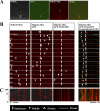Trafficking kinesin protein (TRAK)-mediated transport of mitochondria in axons of hippocampal neurons
- PMID: 21454691
- PMCID: PMC3093881
- DOI: 10.1074/jbc.M111.236018
Trafficking kinesin protein (TRAK)-mediated transport of mitochondria in axons of hippocampal neurons
Abstract
In neurons, the proper distribution of mitochondria is essential because of a requirement for high energy and calcium buffering during synaptic neurotransmission. The efficient, regulated transport of mitochondria along axons to synapses is therefore crucial for maintaining function. The trafficking kinesin protein (TRAK)/Milton family of proteins comprises kinesin adaptors that have been implicated in the neuronal trafficking of mitochondria via their association with the mitochondrial protein Miro and kinesin motors. In this study, we used gene silencing by targeted shRNAi and dominant negative approaches in conjunction with live imaging to investigate the contribution of endogenous TRAKs, TRAK1 and TRAK2, to the transport of mitochondria in axons of hippocampal pyramidal neurons. We report that both strategies resulted in impairing mitochondrial mobility in axonal processes. Differences were apparent in terms of the contribution of TRAK1 and TRAK2 to this transport because knockdown of TRAK1 but not TRAK2 impaired mitochondrial mobility, yet both TRAK1 and TRAK2 were shown to rescue transport impaired by TRAK1 gene knock-out. Thus, we demonstrate for the first time the pivotal contribution of the endogenous TRAK family of kinesin adaptors to the regulation of mitochondrial mobility.
© 2011 by The American Society for Biochemistry and Molecular Biology, Inc.
Figures





References
Publication types
MeSH terms
Substances
Grants and funding
LinkOut - more resources
Full Text Sources
Other Literature Sources

